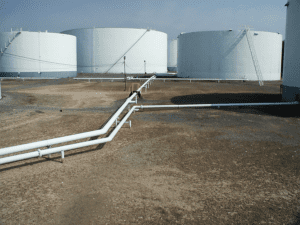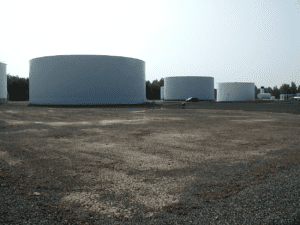Cost of an SPCC Plan
 Do environmental regulations require your facility to have a Spill Prevention, Control, and Countermeasure (SPCC) Plan to achieve environmental compliance? Are you worried that if your SPCC Plan is not done—and done correctly—your facility may be fined and shut down until a compliant SPCC Plan is obtained? Are you unsure of how much obtaining an SPCC Plan is going to cost you? The standards set forth by the U.S. Environmental Protection Agency (EPA) and state regulating agencies can be complicated, so experts are often retained to create SPCC Plans in order to satisfy environmental regulations–which can come at a price. In this article we will review basic information about SPCC Plans and the main factors that affect the SPCC Plan cost.
Do environmental regulations require your facility to have a Spill Prevention, Control, and Countermeasure (SPCC) Plan to achieve environmental compliance? Are you worried that if your SPCC Plan is not done—and done correctly—your facility may be fined and shut down until a compliant SPCC Plan is obtained? Are you unsure of how much obtaining an SPCC Plan is going to cost you? The standards set forth by the U.S. Environmental Protection Agency (EPA) and state regulating agencies can be complicated, so experts are often retained to create SPCC Plans in order to satisfy environmental regulations–which can come at a price. In this article we will review basic information about SPCC Plans and the main factors that affect the SPCC Plan cost.
What is an SPCC Plan?
Businesses in the United States use vast quantities of oil for heat generation, vehicles, and equipment operation. Sometimes, though, oil and oil-based products spill onto land and into waterways during storage, transport, and production activities. In an effort to prevent oil spills and ensure proper cleanup in the event of a spill, the U.S. EPA implemented the Spill Prevention, Control, and Countermeasure Rule in 1974 as a part of the Clean Water Act. The SPCC Rule set forth requirements for the prevention of, preparedness for, and response to oil discharges at specific non-transportation-related facilities. If your facility has a combined aboveground storage capacity greater than 1,320 gallons stored in tanks that hold more than 55 gallons of product or an underground storage capacity greater than 42,000 gallons held in tanks that can store more than 55 gallons of product and are completely buried, you are covered by the SPCC rule.
The objective of these regulations is to prevent oil and oil products from reaching navigable waters and adjoining shorelines, and to contain oil discharges from these facilities. It provides assurance to the EPA that a facility has a process in place to prevent any releases from on-site storage tanks and, in the event of a leak, also has a process to contain any contamination.
The regulation requires facilities to develop and implement SPCC Plans and to establish spill prevention operating procedures to prevent oil spills at the facility, control measures (such as secondary containment) to prevent spills from entering navigable U.S. waters, and countermeasure methods and equipment to clean up and mitigate oil spills that may have impacted the water.
SPCC Plans must be fully reviewed every five years. If there is a change in facility design, construction, operation, or maintenance that materially affects its potential for discharge, an amendment to the SPCC Plan must be completed and reviewed and re-certified by a licensed professional engineer within six months.
What Factors Influence SPCC Plan Cost?
The cost of an SPCC Plan depends largely upon the complexity of the facility and the type of plan it requires. Factors that determine the cost of SPCC Plans include:
- Type of Plan
- Type of Facility
- Size of Facility and Number of Tanks
- Types of Chemicals/Materials Stored
- Site Topography and Setting/Nearby Sensitive Receptors
- Location
- Type and Size of Secondary Containment
- Product Transfer Methods
- Staff Training on Prevention, Control, and Countermeasure
Type of Plan
The type of plan required for your facility is dependent upon the amount of oil stored on your property, spill history of the site, and size of the storage containers. Each tier increases in complexity, and therefore cost:
- Tier I/Self-Certified – less than 10,000 gallons of oil and petroleum on site; no single discharge of product to water or shorelines exceeding 1,000 gallons within 12 months, three years prior to certification date; no two discharges of product exceeding 42 gallons each; little to no piping
- Tier II – less than 10,000 gallons of oil and petroleum, with no tank larger than 5,000 gallons; must meet all Tier I discharge conditions
- Self-Certification is allowed, but a full SPCC Plan is required
- Tier III PE-Certified Full SPCC Plan – more than 10,000 gallons; must meet Tier I and Tier II discharge conditions
Type of Facility
According to the EPA, if a facility stores, processes, refines, uses, or consumes oil and is non-transportation related, it is covered by the SPCC rule. The type of facility you run will determine which type of plan is necessary. Some facilities that are covered by the SPCC rule include:
- Oil drilling, production, storage, and refinery facilities
- Construction sites
- Power generators
- Power transmission and distribution
- Airports
- Marinas
- Fish canneries
- Farms and ranches
- Certain waste treatment facilities
A facility requiring Tier III PE-Certified Full SPCC Plan will cost more than a facility requiring a Tier I/Self-Certified SPCC Plan.
Size of Facility and Number of Tanks
Small facilities require a simpler plan than large facilities. Large facilities in need of a complex plan require more site visits, more detailed documents, more personnel, more research, and more time, which ultimately leads to increased costs.
The number of tanks at the facility—aboveground or underground—will affect the length of the plan, and therefore the cost. More tanks will increase the cost of the plan.
Type of Chemicals/Materials Stored
Hazardous materials may require extra detail and effort in developing a proper SPCC Plan that provides adequate guidelines for protecting the facility and the environment.
Site Topography and Setting/Nearby Sensitive Receptors
If the facility is located on a river or another body of water, in or near a sensitive area, and/or on a sloped landscape, more effort is required to determine if the plan is adequate enough for prevention and control. Adequacy of the plan is based upon whether a spill will be prevented from reaching nearby sensitive receptors.
Location
Depending upon how far your chosen environmental consultant must travel to get to your facility, your cost may increase. If you hire a consultant that best suits your needs but their offices are located several states away, it is likely your cost will increase due to travel time.
 Type and Size of Secondary Containment
Type and Size of Secondary Containment
A secondary containment system provides an extra line of defense to prevent oil from reaching soil and/or water if primary containment fails. Secondary containment is only temporary—proper measures must be taken to clean up the spills from the source of primary containment, then accumulated oil may be removed to prevent it from reaching navigable waters. Possibly the most important aspect of secondary containment is its ability to contain a spill. If the containment is made out of soil, there will be costs associated with confirming its ability to contain a spill. Larger containment requires more testing.
Product Transfer Methods
The methods used to transfer chemicals and materials to and from the facility will affect the cost of your plan. More methods will require a larger plan.
Staff Training
There are costs associated with training the staff on prevention, control, and countermeasure once a new plan is developed.
Typical SPCC Plan Cost
SPCC Plans can be anywhere between 15 to 100 pages long, depending upon the complexity of the facility and can vary in cost accordingly. Ambipar Response EMS provides comprehensive SPCC compliance services for a variety of operations. For a typical site, developing an SPCC Plan from scratch may cost between $8,000 and $12,000, depending upon the factors stated above. Review and re-certification of an SPCC Plan after alterations to storage, products, and/or containment may typically cost between $500 and $1,500.
Our knowledgeable compliance team provides our clients with the expertise necessary to meet their regulatory requirements. Whether you own a small manufacturing facility, a large petroleum terminal, or any size facility in between, a compliant SPCC Plan protects your facility, the environment, and your bottom line. Contact us to further discuss how we can help with your SPCC Plans.


